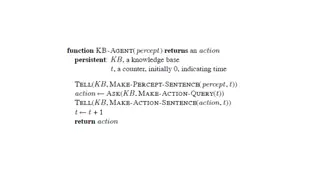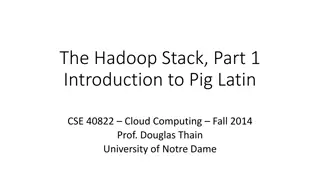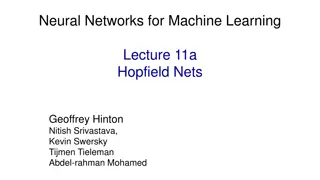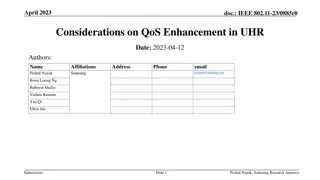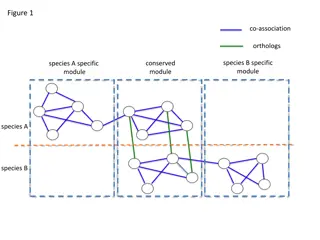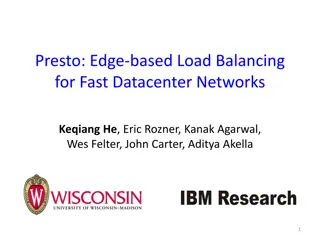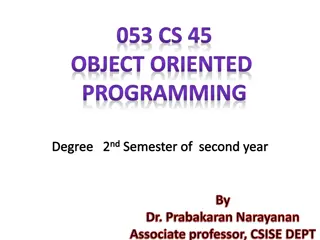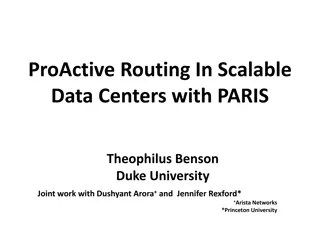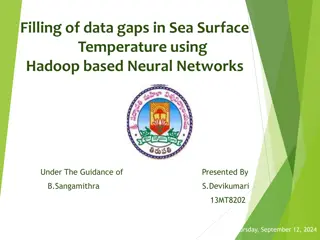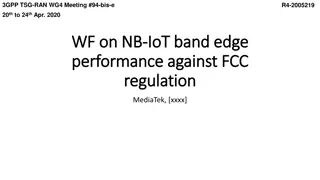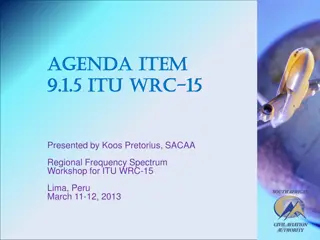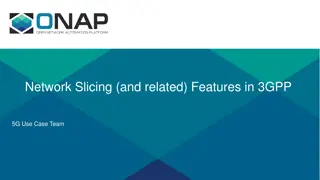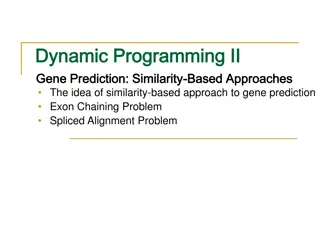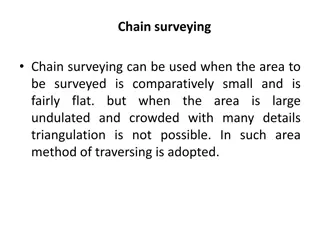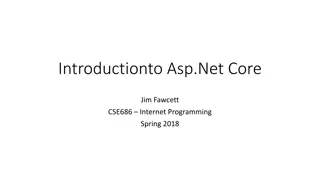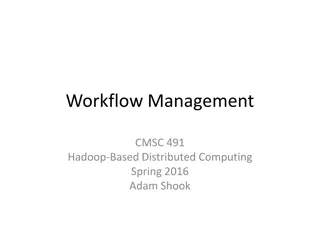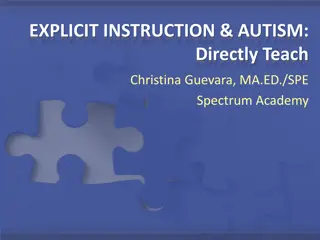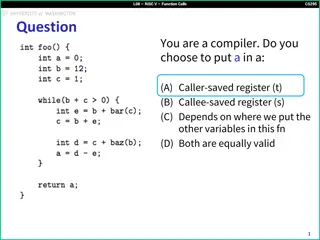Enhancing Service Function Chaining in Edge Data Networks
Introduction of new interfaces and capabilities in 3GPP standards such as Rel-13 and TR 23.718 for improved service function chaining support in Edge Data Networks. Requirements for service functions and controllers in edge environments, considerations for cloud-based and edge-located SFs/SFCs, and activities by other SDOs like ITU-T Y.2242 related to virtualized network functions and service function chaining in mobile networks are discussed.
Download Presentation

Please find below an Image/Link to download the presentation.
The content on the website is provided AS IS for your information and personal use only. It may not be sold, licensed, or shared on other websites without obtaining consent from the author. Download presentation by click this link. If you encounter any issues during the download, it is possible that the publisher has removed the file from their server.
E N D
Presentation Transcript
3GPP Service Function Chaining Support in Edge Data Networks Samar Shailendra
2 Background (1/4) In Rel-13, 3GPP TR 23.718 defines a new interface (St) between the Policy and Charging Rules Function (PCRF) and a new Service Chain Traffic Controller Function (SCTCF). This interface, among other capabilities, allows the PCRF to interface to the SFC controller functions to provide traffic description filters that enable more comprehensive and coordinated implementation service function chains in the Gi-LAN. 2
Background (2/4): Requirements for SFs/SFCs in the Edge 1. SA1: SA1 has identified a need for enhanced SFC support in both the 5GC and beyond the 5GC as stated in subclause 6.35 of TS 22.261, subclause 30.1 of TS 22.101 and subclause 5.2.14 of TS 22.115. 2. SFC in the cloud: There are different optimal locations for service functions: Some should be located closely to Application Clients (such as NAT, firewalls, parental control) while others should be located closely to Application Servers (such as load balancers, KPI monitoring, video optimizers). 3. Edge-located SFs/SFC considerations Locating SFs closely to Application Servers in Edge Data Networks imply the need to locate and manage SFs in Edge Data Networks as well as the cloud. Just like cloud-based SFs/SFCs/ Edge-based SFs/SFCs need to be configured and managed dynamically to support varying traffic patters from ACs to EASs in that Edge. In addition to cloud-based SFs/SFCs, Edge-based SFs/SFCs need to support service continuity upon AC leaving an Edge, and/or AC joining an Edge. This imply possible handling of SFC-context having to be transferred from an SFC in a source Edge to an SFC in a target Edge. Edge-based SFs/SFCs need to be able to handle SFC-aware applications as well as SFC-unaware applications. 3 3
Background (3/4): Other SDOs Activities ITU-T Y.2242 considers the cases when relevant network functions are virtualized and provides Recommendations to support service function chaining in mobile networks. (others: Y. 3300, Suppl 41) Adding network service header (NSH) (agnostic to the underlying transport network type) IETF RFC 7665 and IETF RFC 8300 introduce service function chaining architecture with a chain orchestrator and provide methods of coordinating dynamic service function chaining in mobile networks. IETF proposed Network Services Header (NSH) (1) Data plane encapsulation to direct packets to the requisite functions; (2) per-packet/frame metadata to communicate service requirements and network state between nodes. In summary, Source: IETF 5G network enabling support to consolidate service functions and service function chaining can provide flexibility to manage required service functions into one network instance. The service deployment and configuration can be greatly simplified and at scale. As such, it is foreseen as a promising enhancement to tackle the challenges in 5GS. 4 4
Background (5/5): Other SDOs Activities ITU-T Y2242: Service Aspects: Service Capability and Architecture Figure 1 Network architecture for service function chaining in a mobile network 5
Status Update SA1 WID and CRs WID: SP-201139 (Approved) TS 22.261 (Rel-18 for 5GS): SP-201040 TS 22.101 (pre-Rel-18 including EPS/5GS): S1-204387 TS 22.115 (charging): S1-204389 SA Stage 2 planning for Rel-18 studies: SA2 Future work on SFC enhancement in the EDN/5GC (?) SA5 Future work on SFC management in EDN/5GC (?) SA6 Proposed SID of SFC support in EDNs (?) 6
Architecture Updates Architectures: SFC in 5GC only SFC in Edge only SFC is in both of 5GC and Edge with coordination SFs are owned and deployed on-demand by Operator to enhance the functionality and provide improved QoS/QoE. The SF can include the following functions but not limited to: Network Address Translation (NAT) IP Tunnel Endpoints Packet Classifier Deep Packet Inspection (DPI) Lawful Inspection (LI) TCP Proxies Load balancer Firewall Functions Transcoders URL Filters Video Optimizer 7
SFC is in both of 5GC and Edge EDN NEF EES SMF PCF UE RAN UPF SFC SFC EAS 8
SFC in EDN Edge Data Network Edge Application Server (EAS) SFC in Edge network Edge-X 3GPP Network N6 SF2 SF1 Edge-Y SFP1 Edge Enabler Server (EES) SFP2 EAS can trigger the SFC configuration directly or via EES ! If no configuration triggered, the traffic should skip the SFs. 10
SFC in EDN More details Edge Data Network Edge Application Server (EAS) SFC in Edge-X Edge network N6 3GPP Network SF2 SF1 Edge-Y SFP1 Edge Enabler Server (EES) SFP2 SF5 SF1 SF2 SF3 SF4 SFP-1 SFP-2 Traffic Classifier SFC Controller Edge SFC Enabler 11
SFC Use Cases [1/6] Dynamic chaining of different network functions e.g. NAT, Firewall and Load Balancer. Performance Enhancement Proxies (PEP) for different class of traffic Source : IETF 12
SFC Use Cases [2/6] Traffic Encryption for network/user attack purpose & Requirements of Real time reaction to act over the traffic Identify the malicious encrypted traffic and mitigate the attack right there e.g. Honeypot malware connections. To mitigate an attack once it is detected using an advanced security system that could alter (in real time) the responses of Command in Control channels of the real malware just to disrupt the whole massive attacks. Require SFs (DPI and custom function to mitigate attack) at the edge. Source : Sandvine 13
SFC Use Cases [3/6] Making decisions in Real time for TSN/URLLC related traffic & Requirements of Real time reaction to act over the traffic Making decisions in Real time based on the findings of traffic-identification is the key. e.g. Scheduling and traffic shaping allows for the coexistence of different traffic classes with different priorities on the same network - each with different requirements to available bandwidth and end-to-end latency. The IEEE 802.1 Time-Sensitive Networking Task Group specifies several different schedulers and traffic shapers that can be combined to achieve the nonreactive coexistence of hard real-time, soft real-time and background traffic on the same Ethernet infrastructure. SFC at the edge will insert DPI-SF on need basis. Decision needs to be done locally in real time, and delay can be detrimental. Source : Sandvine 14
SFC Use Cases [4/6] Massive distributed and automated attack e.g. There is a prevalent class of automated malicious attacks, working in sync and fully distributed across various network domains, pretending to be a reliable application, often hosted on IoT devices. Breaching a specific mobile OS version achieves hundreds of thousands of devices to generate later synced, and massive attack to the network. The Problem How to detect if an automation attack is present in the network. How to protects and enables your web and mobile applications Possible Solution Deploying traffic Identification engines in each N6 interface, each one talking to a centralized analytics engine (could be a global NWDAF) to correlate common and distributed events happening in the Network and to act in a very orchestrated way across the network. SFC can be used to deploy in strategic N6 monitoring of traffic at one or some of the malicious traffic locations in collaboration with the 5GC. Source : Sandvine 15
SFC Use Cases [5/6] Mashup Application correlation, coordination and charging across multiple interconnected applications The Application identification has to be done based on a coordinated process of identification of several traffics/protocols in the same or different n/w slices The charging has to be done per Mashup Application and not per traffic per slice. Equivalent principles, applies in case of sponsored or zero-rating Mashup Application SFC at the edge can help in correlating the interconnected application traffic. Coordination with the SFC/PCF/SMF at the core for charging. Source : Sandvine 16
SFC Use Cases [6/6] Other Use Cases (non)Subscriber based and pure/mixed SDN-NFV environment In real time, using the payload information of the user packet connection and/or service destination or any non-user data, a specific path is defined for a specific flow of the user using some specific SFs (e.g. parental control) and/or legacy SFs (e.g. optimizer) and finally internet. using some specific NF services (eg. parental control + optimizer) and finally internet. Network Reliability in SDN-NFV/legacy environments In real time, using the payload information of the user packet connection and/or service destination or any non-user data a specific path is defined for a specific flow of the user using some specific services (eg. parental control + optimizer) and finally internet. In the event if one of this instance shutdown the user data flow is diverted to other instance of same service automatically and in real-time. Payload content triggers instantiation of specialized module In real time, the service layer triggers broadly instantiation of specialized module (could be DPI for traffic identification) in most of N6 interfaces across all EDGE sites and central sites. Source : Sandvine 17
Tentative work split between SA2 and SA6 SA2 Define SFC, SFC Policies, relationship between the SFC policy and traffic steering policies, northbound APIs for AFs to request SFC, and applying these policies to UE as well. SA6 Investigate SFC in edge network, integration of SFC within EDGEAPP architecture, enhancement to EEL, co-ordination with SFC in core, interfaces with EAS/EES, APIs for SFC provisioning, handling service continuity and policy enforcement at the edge with UE mobility. 18


